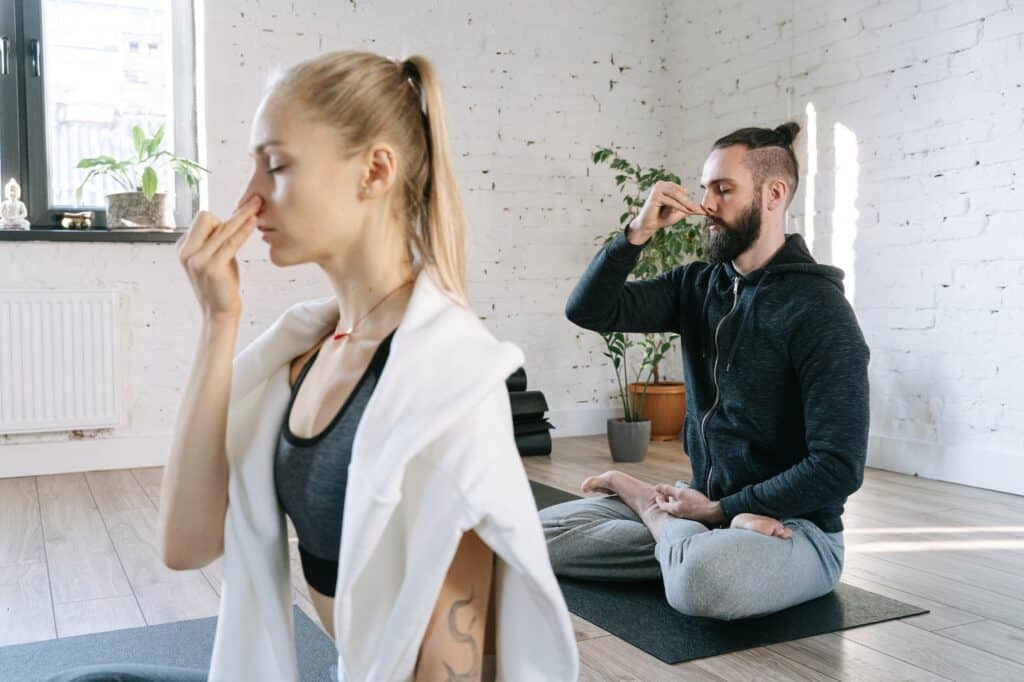What is Breathwork?
Breathwork refers to the mindfulness practice of conscious breathing. It teaches various techniques aimed to consciously regulate and control breathing patterns to promote physical, mental, and emotional well-being. There are various types of breathwork techniques, including Pranayama, Holotropic Breathwork, and Wim Hof Method, among others. The goal of breathwork is to improve the flow of oxygen in the body and help to reduce symptoms of stress, anxiety, and other mental and physical health issues.
The Science of Breathwork and Anxiety
Breathwork is a natural way to activate the body’s relaxation response and promote feelings of calm and relaxation. Studies have shown that breathwork techniques can reduce anxiety levels, increase feelings of well-being, and improve overall mental health. Here are some of the science-backed links between breathwork and anxiety:
Reduced Symptoms of Anxiety
One of the most significant benefits of breathwork is its ability to reduce symptoms of anxiety. A study published in the Journal of Psychiatric Research found that slow breathing exercises were effective in reducing anxiety symptoms in individuals with Generalized Anxiety Disorder (GAD). The breathwork technique of deep belly breathing, also known as diaphragmatic breathing, has been shown to activate the parasympathetic nervous system, which is responsible for promoting relaxation and reducing stress levels. By slowing down and regulating breathing patterns, breathwork can reduce anxiety levels and promote a sense of calm.
Improves Cognitive Function
Breathwork has also been shown to improve cognitive function, which can be particularly beneficial for people with anxiety disorders. A study published in the Journal of Neuroscience found that deep breathing can improve cognitive function by increasing the flow of oxygen to the brain, increasing focus and productivity.
Enhanced Relaxation Response
Breathwork can also help to enhance the bodily relaxation response in the body, which can counteract the effects of the stress response. The relaxation response is a state of deep relaxation that can help to reduce anxiety and promote feelings of calmness and well-being. Behavioural changes went from high levels of arousal, anxiety, depression to increased comfort, relaxation, pleasantness, and alertness. A study published in the Journal of Alternative and Complementary Medicine found that a specific type of breathwork called Sudarshan Kriya Yoga (SKY) was effective in enhancing the relaxation response in individuals with anxiety disorders.

How to Tap into the Incredible Power of The Breath
Here are a few practices to check out that I’ve found most helpful. The key is good posture and dedication and patience to the time this takes:
- Belly Breathing – also known as diaphragmatic breathing, focuses and reminds us to breathe deeply into our belly, rather than into our chest, to promote a feeling of calm.
How to do it:
Sitting or lying wherever feels most comfortable, place one hand on your chest and the other hand just below your rib cage. Inhale through your nose, so that you feel the breath move down and your belly rise. Exhale through your mouth, so that your hand just below your rib cage falls inward. The hand on your chest should remain still. Repeat this however many times feels comfortable. - Relaxing Breathing – the intention with this exercise is to slow your heart rate and bring your consciousness to the moment. It teaches you to take in less and release more, making it effective in stressful situations.
How to do it:
Start by releasing all the air from your chest. Then inhale through your nose for 4 seconds, then hold your breath for 7 seconds, and then exhale out of the mouth for 8 seconds. Repeat this cycle up to four times. - Alternate Nostril Breathing – This is a technique that works by creating a channel of flow from one nostril to the other. Alternate nostril breathing calms and can also be a valuable tool for harnessing awareness.
How to do it:
Begin by gently closing your right nostril with your right thumb. Inhale slowly through your left nostril for 7 seconds. Then pause and gently close your left nostril with your right ring finger and exhale through the right nostril for 7 seconds. Repeat, alternating inhaling on the left and exhaling on the right, for a few moments.
Breathwork in Summary
Breathwork is a powerful tool for improving overall health and well-being, and the science-backed links between breathwork and anxiety are significant. By practicing breathwork techniques, individuals can reduce symptoms of anxiety, improve heart rate variability, enhance the relaxation response, and improve emotional regulation. If you are struggling with low-level anxiety, consider incorporating breathwork into your daily routine to experience the benefits for yourself. Benefits of Mindfulness offer a selection of beginner mindfulness exercises that incorporate some basic breathwork techniques




